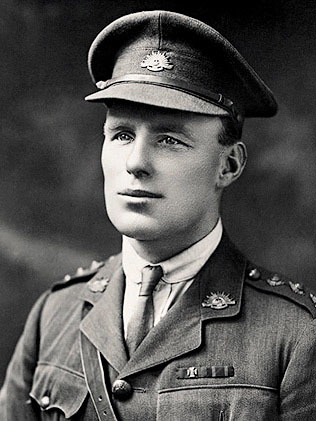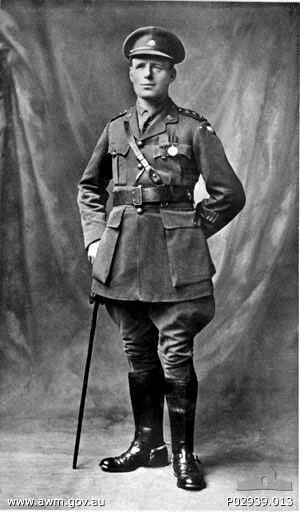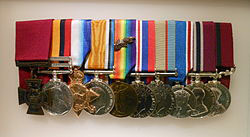James Ernest Newland was born in the Geelong suburb of Highton, Victoria, on 22nd August 1881, the son of labourer and railway worker William Newland and his wife Louisa Jane (née Wall). In 1899 he enlisted in the Commonwealth Military Forces as private 2354 and was assigned to the 4th Battalion, Australian Commonwealth Horse. Newland saw short active service in Cape Town during the Second Boer War with the 4th Battalion arriving just before the peace treaty was signed. He returned to Victoria, Australia in 1902.
Newland joined the Royal Australian Artillery at Fort Queenscliff in July the 1903. The Victorian Artillery Descriptive Roll has the following details for James Newland:
(Regimental Number) 1439, (Name) Newland, Jas. Ernest, (Date of Birth) 22.8.81 (Where Born) Geelong Corio (Height) 5’ 8¼” (Eyes) blue (Hair) fair (Complexion) fair (Appearance) smart (religion) Wes (Calling) Farm Labourer (Marks or Scars) nil (Next of Kin) W.A. Newland F [father] (Address) PO Laverton (Appointments) Gunner 27.7.03 Acting Bomr. 3.12.04 (sic) Bomr. 1.11.04 Corpl. 1.12.15.
Four years later, in September 1907, he transferred to the militia. Newland left the militia and relocated to Tasmania where, in 1909, he became a police officer in the Tasmanian Police Force. In August 1910 he re-enlisted in the permanent army. On 27th December 1913, James Ernest Newland married 32 year-old Florence May Mitchell at Sheffield, Tasmania. Newland served with the Australian Instructional Corps in Hobart up to the start of the First World War.
In Pontville, Tasmania, Newland transferred to the A.I.F twelve days after the British Empire’s declaration of war on Germany and her allies. He was posted as the Regimental Quartermaster Sergeant of the 12th Battalion. On 20th October he left for Egypt with the battalion on board HMAT Geelong. From arrival in Egypt the 12th Battalion spent the next four months training in the desert.
At 4:30am 25th April, 1915 the 12th Battalion, as part of the 3rd Australian Brigade, was one of the first units on shore at ANZAC Cove forming part of the covering force.
Newland received a gunshot wound to his shoulder three days after the landing and was evacuated to the 1st General Hospital. While convalescing at the hospital, on 22nd May, he was commissioned as a Second Lieutenant and returned to the Battalion only four days later on 26th May. Newland was withdrawn from Gallipoli 9th June when he was given command of the 12th Battalion’s transport elements in Maadi, Egypt. He held this position for the rest of 1915, being promoted to Lieutenant in October and spending over a week hospitalised in Gezireh with dengue fever in November. He was made adjutant of the 12th Battalion two weeks after his promotion to Captain on the 1st March, 1916. Later that month the Battalion, with Newland, headed for the Western Front in France.

After arrival at Marseilles, Newland and the 12th Battalion were involved in small operations at the Fleurbaix sector of France before being sent to the Somme in July 16. Seven days later Newland’s battalion was involved in its first major battle in France at Pozieres. The day after the battle, 8th August 1916, Newland took command of A Company which was relocated, with the rest of the 12th Battalion, to the grotesquely nicknamed Sausage Valley. Here they were to prepare for the Mouquet Farm battle to come.
The utterly devastated Mouquet Farm had links to well established German positions as part of the Thiepval defences. Newland led A Company in an assault upon enemy trenches to the North East of the farm ruins. By 18:30 on 21st August Newland and the company had captured its objectives. Despite attempts by his men to go after the retreating enemy, Newland was able to strengthen their position and consolidate the trenches by early morning the next day. For his “courage under heavy fire” he was recommended for the Military Cross. The recommendation was acknowledged but downgraded to Mention in Despatches for conspicuous courage, powers of leadership and organising. It was published in the London Gazette on the 4th January 1917.
From Poziers and Mouquet Farm, the 12th Battalion was temporarily transferred to the Ypres region before returning to the Somme in late October. During December at Bernafay Wood, Newland was admitted to the 38th Casualty Clearing Station with pyrexia (fever). On the day he was released from the 2nd General Hospital at Le Havre, Newland was attached to the headquarters of the 2nd Australian Brigade as a staff officer. Newland rejoined A Company 12th Battalion after taking leave in January 1917. On the 26th of February 1917, the 12th Battalion attacked the village of La Barque as the Germans retreated to the Hindenburg Line. After attacking a German strongpoint Newland received a gunshot wound to his face. He was admitted to the 1st Australian Field Ambulance, and returned to the 12th Battalion a month later on 25th March after recuperating in Boulogne at the 7th Stationary Hospital.
In early April 1917 the Germans held the villages of Boursies, Demicourt and Hermies which were between the Hindenburg Line and the area to the south of the I Anzac Corps. Newland was charged with the capture of Boursies. The attack was planned as a feint to mislead the German forces on the direction from which a larger assault was to be made on Hermies. A Company, with a platoon from B Company, began the advance on the village along the Bapaume-Cambrai road. They found themselves under heavy rifle and machine gun fire from a derelict mill approximately 400 metres before the village. Rallying his men, despite heavy casualties, Newland charged the German position with grenades. The enemy were scattered and A Company held the mill and continued with the advance into Boursies.
The Company was under heavy shellfire all day on 8th April. The enemy counter-attacked with a firestorm of bombs and trench mortars against Newland’s men holding the old mill. The Germans had some initial success and entered the forward posts of the mill, which were occupied by a platoon of Newland’s men under the command of Sergeant John Whittle. Newland, bringing up a platoon from the Battalion’s reserve company, charged the attackers and took the lost ground with Whittle’s assistance. After capturing Boursies with 240 casualties, including 70 killed or missing, the 11th battalion arrived to relieve Newland and the men of the 12th.
On 14th April the 12th Battalion was sent to Lagnicourt to relieve the 9th Battalion. The following morning the 1st Australian Division’s line was counter-attacked. To the right of Newland’s men the 12th Battalion’s D Company was overrun, allowing the Germans to break through the line. Surrounded and under attack on three sides, Newland withdrew the company to a sunken road and deployed the diminished A Company in defensive positions on each bank. Newland’s company repelled the enemy several times. Noting that the German assaults were waning Newland took a group of twenty men and charged at the enemy capturing forty prisoners.
By 11:00 a counter-attack by Newland’s company and newly arrived reinforcements from the 9th battalion had recaptured the line. The 12th Battalion suffered 125 casualties, including 66 killed or missing.
For his actions on three separate occasions during the assault, Newland was awarded the Victoria Cross, the highest decoration for gallantry “in the face of the enemy” that can be awarded to members of the British and Commonwealth armed forces.
At 35 years and 7 months, Newland was also the oldest Australian Victoria Cross recipient of the First World War. Sergeant Whittle was also awarded the Victoria Cross, which made the two of them the only permanent members of the Australian military to be awarded the medal during the Great War.
The full citation for Newland’s Victoria Cross appeared in a supplement to the London Gazette on 8th June, 1917:
His Majesty the KING has been graciously pleased to approve of the award of the Victoria Cross to the undermentioned Officers, Non-commissioned Officers and Men: — Capt. James Ernest Newlands, [sic] Inf. Bn., Aus. Imp. Force. For most conspicuous bravery and devotion to duty, in the face of heavy odds, on three separate occasions. On the first occasion he organised the attack by his company on a most important objective, and led personally, under heavy fire, a bombing attack. He then rallied his company, which had suffered heavy casualties, and he was one of the first to reach the objective. On the following night his company, holding the captured position, was heavily counter-attacked. By personal exertion, utter disregard of fire, and judicious use of reserves, he succeeded in dispersing the enemy and regaining the position. On a subsequent occasion, when the company on his left was overpowered and his own company attacked from the rear, he drove off a combined attack which had developed from these directions. These attacks were renewed three or four times, and it was Capt. Newland’s tenacity and disregard for his own safety that encouraged the men to hold out. The stand made by this officer was of the greatest importance, and produced far-reaching results.
The 12th Battalion joined the British and Australian attempt to capture the village of Bullecourt in May 1917. Newland was wounded for the third time on 6th May during the assault on Bullecourt. Initially he was admitted to the 5th Field Ambulance with a gunshot to his left armpit. The next day he was transferred to No. 1 Red Cross Hospital, Le Touquet. Newland was then transferred to a British hospital eight days later. Newland attended an investiture ceremony at Buckingham Palace on 21st July, where he was decorated with his Victoria Cross by King George V.
Newland boarded a ship back to Australia, arriving in Melbourne on 18th September. He immediately travelled home to Tasmania. He was discharged medically unfit from the Australian Imperial Force on 2nd March 1918.
In recognition of their valour the management of the Tivoli presented Newland and other surviving VC recipients each with a life pass to their theatres. Newland retained the rank of Captain and returned to service with the permanent military forces. He held various appointments in the army, including adjutant and quartermaster of the 8th, 49th, 52nd, 38th and 12th Battalions, as well as area officer and recruiting officer.
Sadly, Newland’s wife Florence died of tuberculosis in 1924. On 30th April 1925, he married Heather Vivienne Broughton in a ceremony at St Paul’s Anglican Church, Bendigo. The couple would later have a daughter.
Promoted to major on 1 May 1930, Newland was awarded the Meritorious Service Medal in 1935. Newland was seconded for duties as quartermaster instructor at the 4th Division headquarters at the outbreak of the Second World War. On 10 May 1940, he assumed his final army appointment as Quartermaster, A Branch, at Army Headquarters in Melbourne. He served in this position until August 1941, when he was placed on the retired list with the honorary rank of Lieutenant Colonel.
After his military retirement, Newland served as Assistant Commissioner of the Australian Red Cross Society in the Northern Territory during the later months of 1941. He joined the inspection staff at the Footscray Ammunition Factory in January 1942. On 19th March, 1949 James Ernest Newland passed away suddenly of heart failure at 54 Briggs Street, Caulfield, Victoria. He was 67 years old. He was accorded a funeral with full military honours, and was buried in the Methodist section at Brighton Cemetery. Vivienne passed away in 1977. Newland’s daughter, Dawn, donated her father’s medals to the Australian War Memorial in Canberra. A collection of items belonging to Newland comprising of his First World War uniform, replica medals, photographs and documentation are displayed at Fort Queenscliff along with the Victorian Artillery Descriptive Roll.
Contact Jason McGregor about this article.








